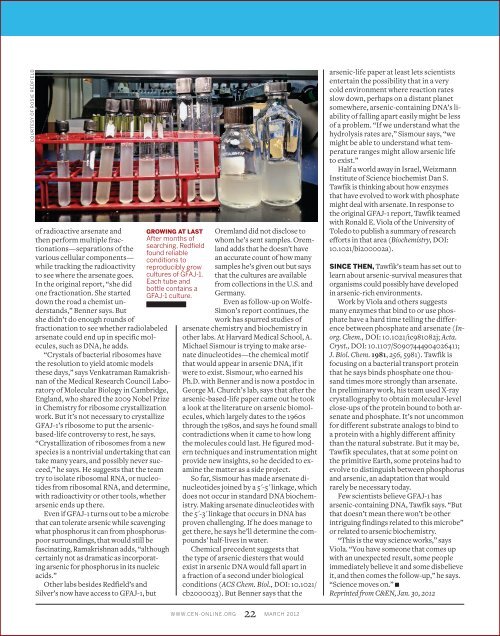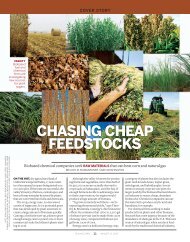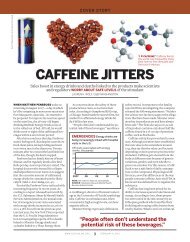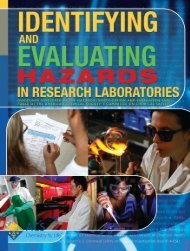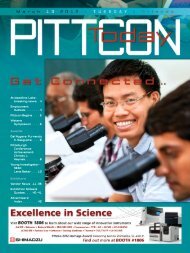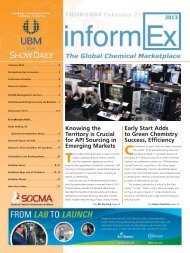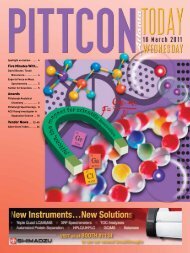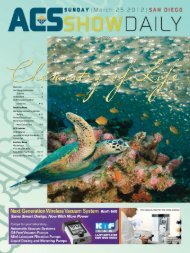focus on life sciences - Chemical & Engineering News - American ...
focus on life sciences - Chemical & Engineering News - American ...
focus on life sciences - Chemical & Engineering News - American ...
- No tags were found...
You also want an ePaper? Increase the reach of your titles
YUMPU automatically turns print PDFs into web optimized ePapers that Google loves.
COURTESY OF ROSIE REDFIELDof radioactive arsenate andthen perform multiple fracti<strong>on</strong>ati<strong>on</strong>s—separati<strong>on</strong>sof thevarious cellular comp<strong>on</strong>ents—while tracking the radioactivityto see where the arsenate goes.In the original report, “she did<strong>on</strong>e fracti<strong>on</strong>ati<strong>on</strong>. She starteddown the road a chemist understands,”Benner says. Butshe didn’t do enough rounds offracti<strong>on</strong>ati<strong>on</strong> to see whether radiolabeledarsenate could end up in specific molecules,such as DNA, he adds.“Crystals of bacterial ribosomes havethe resoluti<strong>on</strong> to yield atomic modelsthese days,” says Venkatraman Ramakrishnanof the Medical Research Council Laboratoryof Molecular Biology in Cambridge,England, who shared the 2009 Nobel Prizein Chemistry for ribosome crystallizati<strong>on</strong>work. But it’s not necessary to crystallizeGFAJ-1’s ribosome to put the arsenicbased-<strong>life</strong>c<strong>on</strong>troversy to rest, he says.“Crystallizati<strong>on</strong> of ribosomes from a newspecies is a n<strong>on</strong>trivial undertaking that cantake many years, and possibly never succeed,”he says. He suggests that the teamtry to isolate ribosomal RNA, or nucleotidesfrom ribosomal RNA, and determine,with radioactivity or other tools, whetherarsenic ends up there.Even if GFAJ-1 turns out to be a microbethat can tolerate arsenic while scavengingwhat phosphorus it can from phosphoruspoorsurroundings, that would still befascinating, Ramakrishnan adds, “althoughcertainly not as dramatic as incorporatingarsenic for phosphorus in its nucleicacids.”Other labs besides Redfield’s andSilver’s now have access to GFAJ-1, butGROWING AT LASTAfter m<strong>on</strong>ths ofsearching, Redfieldfound reliablec<strong>on</strong>diti<strong>on</strong>s toreproducibly growcultures of GFAJ-1.Each tube andbottle c<strong>on</strong>tains aGFAJ-1 culture.Oremland did not disclose towhom he’s sent samples. Oremlandadds that he doesn’t havean accurate count of how manysamples he’s given out but saysthat the cultures are availablefrom collecti<strong>on</strong>s in the U.S. andGermany.Even as follow-up <strong>on</strong> Wolfe-Sim<strong>on</strong>’s report c<strong>on</strong>tinues, thework has spurred studies ofarsenate chemistry and biochemistry inother labs. At Harvard Medical School, A.Michael Sismour is trying to make arsenatedinucleotides—the chemical motifthat would appear in arsenic DNA, if itwere to exist. Sismour, who earned hisPh.D. with Benner and is now a postdoc inGeorge M. Church ’s lab, says that after thearsenic-based-<strong>life</strong> paper came out he tooka look at the literature <strong>on</strong> arsenic biomolecules,which largely dates to the 1960sthrough the 1980s, and says he found smallc<strong>on</strong>tradicti<strong>on</strong>s when it came to how l<strong>on</strong>gthe molecules could last. He figured moderntechniques and instrumentati<strong>on</strong> mightprovide new insights, so he decided to examinethe matter as a side project.So far, Sismour has made arsenate dinucleotidesjoined by a 5ʹ-5ʹ linkage, whichdoes not occur in standard DNA biochemistry.Making arsenate dinucleotides withthe 5ʹ-3ʹ linkage that occurs in DNA hasproven challenging. If he does manage toget there, he says he’ll determine the compounds’half-lives in water.<strong>Chemical</strong> precedent suggests thatthe type of arsenic diesters that wouldexist in arsenic DNA would fall apart ina fracti<strong>on</strong> of a sec<strong>on</strong>d under biologicalc<strong>on</strong>diti<strong>on</strong>s ( ACS Chem. Biol., DOI: 10.1021/cb2000023 ). But Benner says that thearsenic-<strong>life</strong> paper at least lets scientistsentertain the possibility that in a verycold envir<strong>on</strong>ment where reacti<strong>on</strong> ratesslow down, perhaps <strong>on</strong> a distant planetsomewhere, arsenic-c<strong>on</strong>taining DNA’s liabilityof falling apart easily might be lessof a problem. “If we understand what thehydrolysis rates are,” Sismour says, “wemight be able to understand what temperatureranges might allow arsenic <strong>life</strong>to exist.”Half a world away in Israel, WeizmannInstitute of Science biochemist Dan S.Tawfik is thinking about how enzymesthat have evolved to work with phosphatemight deal with arsenate. In resp<strong>on</strong>se tothe original GFAJ-1 report, Tawfik teamedwith R<strong>on</strong>ald E. Viola of the University ofToledo to publish a summary of researchefforts in that area ( Biochemistry, DOI:10.1021/bi200002a ).SINCE THEN, Tawfik’s team has set out tolearn about arsenic-survival measures thatorganisms could possibly have developedin arsenic-rich envir<strong>on</strong>ments.Work by Viola and others suggestsmany enzymes that bind to or use phosphatehave a hard time telling the differencebetween phosphate and arsenate ( Inorg.Chem., DOI: 10.1021/ic981082j ; Acta.Cryst., DOI: 10.1107/S0907444904026411 ;J. Biol. Chem. 1981 , 256, 5981 ). Tawfik is<str<strong>on</strong>g>focus</str<strong>on</strong>g>ing <strong>on</strong> a bacterial transport proteinthat he says binds phosphate <strong>on</strong>e thousandtimes more str<strong>on</strong>gly than arsenate.In preliminary work, his team used X-raycrystallography to obtain molecular-levelclose-ups of the protein bound to both arsenateand phosphate. It’s not uncomm<strong>on</strong>for different substrate analogs to bind toa protein with a highly different affinitythan the natural substrate. But it may be,Tawfik speculates, that at some point <strong>on</strong>the primitive Earth, some proteins had toevolve to distinguish between phosphorusand arsenic, an adaptati<strong>on</strong> that wouldrarely be necessary today.Few sci entists believe GFAJ-1 hasarsenic-c<strong>on</strong>taining DNA, Tawfik says. “Butthat doesn’t mean there w<strong>on</strong>’t be otherintriguing findings related to this microbe”or related to arsenic biochemistry.“This is the way science works,” saysViola. “You have some<strong>on</strong>e that comes upwith an unexpected result, some peopleimmediately believe it and some disbelieveit, and then comes the follow-up,” he says.“Science moves <strong>on</strong>.” ◾Reprinted from C&EN, Jan. 30, 2012WWW.CEN-ONLINE.ORG 22 MARCH 2012


